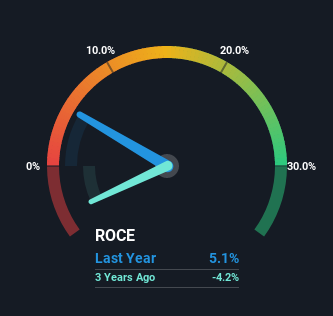- United States
- /
- Energy Services
- /
- NYSE:NOV
NOV (NYSE:NOV) Is Looking To Continue Growing Its Returns On Capital

If you're not sure where to start when looking for the next multi-bagger, there are a few key trends you should keep an eye out for. One common approach is to try and find a company with returns on capital employed (ROCE) that are increasing, in conjunction with a growing amount of capital employed. This shows us that it's a compounding machine, able to continually reinvest its earnings back into the business and generate higher returns. With that in mind, we've noticed some promising trends at NOV (NYSE:NOV) so let's look a bit deeper.
Understanding Return On Capital Employed (ROCE)
For those who don't know, ROCE is a measure of a company's yearly pre-tax profit (its return), relative to the capital employed in the business. The formula for this calculation on NOV is:
Return on Capital Employed = Earnings Before Interest and Tax (EBIT) ÷ (Total Assets - Current Liabilities)
0.051 = US$391m ÷ (US$10b - US$2.4b) (Based on the trailing twelve months to December 2022).
Therefore, NOV has an ROCE of 5.1%. Ultimately, that's a low return and it under-performs the Energy Services industry average of 9.0%.
Check out our latest analysis for NOV

Above you can see how the current ROCE for NOV compares to its prior returns on capital, but there's only so much you can tell from the past. If you're interested, you can view the analysts predictions in our free report on analyst forecasts for the company.
So How Is NOV's ROCE Trending?
Like most people, we're pleased that NOV is now generating some pretax earnings. Historically the company was generating losses but as we can see from the latest figures referenced above, they're now earning 5.1% on their capital employed. In regards to capital employed, NOV is using 57% less capital than it was five years ago, which on the surface, can indicate that the business has become more efficient at generating these returns. NOV could be selling under-performing assets since the ROCE is improving.
For the record though, there was a noticeable increase in the company's current liabilities over the period, so we would attribute some of the ROCE growth to that. Essentially the business now has suppliers or short-term creditors funding about 24% of its operations, which isn't ideal. It's worth keeping an eye on this because as the percentage of current liabilities to total assets increases, some aspects of risk also increase.
The Bottom Line On NOV's ROCE
From what we've seen above, NOV has managed to increase it's returns on capital all the while reducing it's capital base. And since the stock has fallen 49% over the last five years, there might be an opportunity here. So researching this company further and determining whether or not these trends will continue seems justified.
NOV does have some risks though, and we've spotted 2 warning signs for NOV that you might be interested in.
For those who like to invest in solid companies, check out this free list of companies with solid balance sheets and high returns on equity.
Valuation is complex, but we're here to simplify it.
Discover if NOV might be undervalued or overvalued with our detailed analysis, featuring fair value estimates, potential risks, dividends, insider trades, and its financial condition.
Access Free AnalysisHave feedback on this article? Concerned about the content? Get in touch with us directly. Alternatively, email editorial-team (at) simplywallst.com.
This article by Simply Wall St is general in nature. We provide commentary based on historical data and analyst forecasts only using an unbiased methodology and our articles are not intended to be financial advice. It does not constitute a recommendation to buy or sell any stock, and does not take account of your objectives, or your financial situation. We aim to bring you long-term focused analysis driven by fundamental data. Note that our analysis may not factor in the latest price-sensitive company announcements or qualitative material. Simply Wall St has no position in any stocks mentioned.
About NYSE:NOV
NOV
Designs, constructs, manufactures, and sells systems, components, and products for oil and gas drilling and production, and industrial and renewable energy sectors in the United States and internationally.
Very undervalued with flawless balance sheet.


